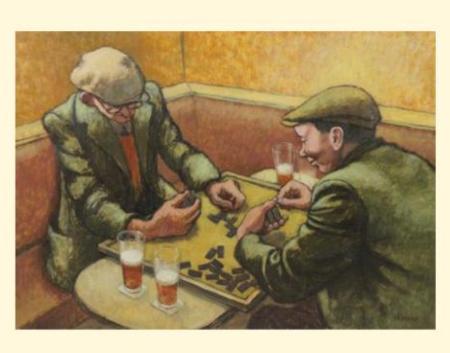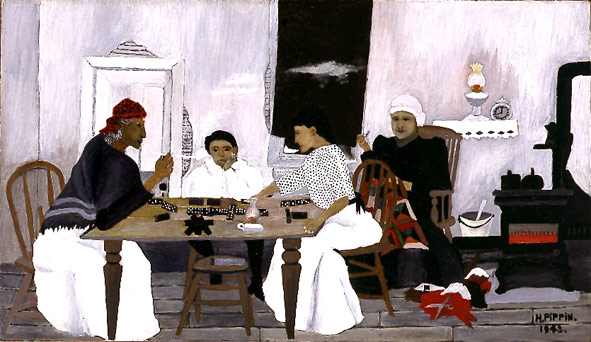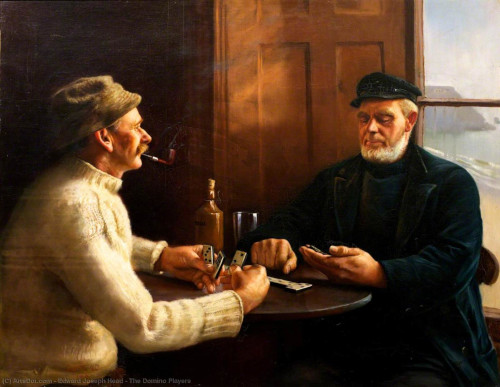Great Little-Known Dominoes Games

Try these great little-known dominoes games...

| Game | Players | Level | Description |
|---|---|---|---|
| 42 & variants |
4 | Medium | Trick-taking with dominoes.... the addictive "national game" of Texas |
| Moon | 3 or 4 | Easy | An easier trick-taking game with dominoes. Much like Whist. |
| 11 Point Black Tile | 3 or 4 | Medium | A Hearts-like game in which you avoid winning certain dominoes in tricks. A real mindbender for card players because each tile is a member of two suits. |
| Five-Up | 2 | Medium | Most elite of traditional dominoes "scoring games" |
| Domino Cubano | 4 | Medium | Best of the traditional dominoes "layout games" |
Game Descriptions
By Howard Fosdick © BestFreeNewGames.com
Here are some great dominoes games we've run across through the years. Let's describe these games and why you'll like them.
Texas 42, or just 42, was invented by two schoolboys in Texas in the 1880s. The lads were punished for playing with cards, which were prohibited by religious taboo at the time. The clever youngsters realised that they could play a similar trick-taking game with dominoes, and so they invented 42.
Without benefit of publicity, on its merits alone, 42 spread throughout Texas and even into neighboring states. Today it's considered the "national game of Texas".
And with good reason. Somehow playing a card game with dominoes becomes addictive. We've included 42 here because it's one of the best "card games" we've ever played.
We also include rules for larger numbers of players. (These rules are rather hard to find, even with the internet).
And we offer our own invention, The Big Game, that maps the 7 tricks played in 42 onto a larger palette of 11 tricks. The Big Game is a mathematically accurate extension of 42 to a longer, more complex game. If you like 42, try it for a new challenge.
We also include a trick-taking game called Moon. Whereas 42 players try to capture particular high-value tiles in tricks, in the simpler Moon, each trick is worth 1 point. So it's rather like Whist for dominoes.
Moon works well for three players, whereas 42 and The Big Game are strictly for four players divided into two partnerships. 42 players will often play Moon when a fourth is not available. But few would argue that it's as good a game as the truly inspired 42.
For this reason, I invented Domino Whist. Domino Whist takes the one-point-per-trick principle that underlies Moon to the same heights as 42 does with its high-value tiles. You can play Domino Whist with 3, 4, or 5 players. We guarantee you'll find it absorbing.

Here's one last trick-taking game played with dominoes. This time you try to avoid winning certain tiles in tricks, much like the card game, Hearts. But unlike Hearts, each domino is a member of two suits. This is real mindbender for card players and it makes for a very entertaining change of pace.
Finally, you might like to read our article on all domino trick-taking games. This essay describes the different trick-taking domino games, what makes each unique, and why you'll like playing them.
Five-Up is another regional domino game that deserves a wider audience. The game evolved in the San Fransisco area in the early 19th century. A gentleman banker named Dominic Armanino did much to popularise the game in the 1950s and 1960s. He wrote a series of books on Five-Up that elaborate upon strategies in some detail.
Five-Up is a scoring game, rather than a traditional dominoes block or draw game. Players score points for every multiple of five they create by playing their tiles. What makes File-Up especially interesting is that every double is a spinner. That is, play can extend in up to four directions from every doublet. Needless to say, combined with the scoring system, this makes for a intricate and challenging game.
Domino Cubano, or Cuban Dominoes, is a traditional dominoes layout game. Players extend lines of play in two directions from the initial tile.
What makes Domino Cubano interesting is that it uses a 9-9 set, making the game infinitely more interesting than all the other "block" dominoes games played with 6-6 sets. It's strictly a partnership game, and this adds another layer of strategy as players struggle to aid their partner while thwarting their opponents.
Domino Cubano, along with Cubilete, are together usually considered the "national games" of Cuba. In the U.S., it’s played wherever Cuban-Americans gather -- at “domino plaza” in Miami, the Cuban Chamber of Commerce in Chicago, the Atlanta Cuba Club, and at the Cuban Festival in Houston every May. Watch a game among experienced players, and you'll be forced to agree that dominoes is no "kids' game"... even when played as a "simple" block game like Domino Cubano.

